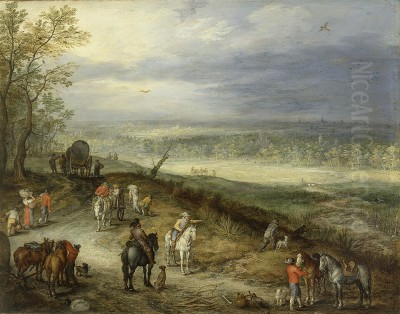
Jan Brueghel the Elder stands as a pivotal figure in Flemish art, bridging the late Renaissance and the burgeoning Baroque era. Born into an artistic dynasty and forging his own distinct path, he became renowned for his exquisitely detailed paintings, earning him nicknames like "Velvet," "Flower," and "Paradise" Brueghel. His prolific output spanned landscapes, still lifes, allegorical scenes, and mythological subjects, often executed with a jewel-like precision on copper panels. A master collaborator, most famously with Peter Paul Rubens, and a shrewd navigator of the art market, Brueghel left an indelible mark on the art of the Low Countries and beyond.
An Artistic Lineage: The Brueghel Family Context
Jan Brueghel the Elder (1568–1625) was born in Brussels into arguably the most famous artistic family of the Southern Netherlands. His father was the legendary Pieter Bruegel the Elder (c. 1525–1569), whose panoramic landscapes and insightful depictions of peasant life revolutionized Northern European art. Pieter the Elder died when Jan was only about a year old, meaning Jan could not have received direct training from him. However, the immense artistic legacy and the environment shaped by his father's fame undoubtedly influenced his path.
Jan's older brother, Pieter Brueghel the Younger (1564–1638), also became a successful painter. Often called "Hell Brueghel" for his early fascination with scenes of fire and grotesque figures, Pieter the Younger primarily built his career on producing numerous copies and variations of their father's most popular compositions. While both brothers operated successful workshops in Antwerp, their artistic temperaments and outputs differed significantly. Jan pursued innovation and refinement in new genres, while Pieter the Younger focused more on replicating established successes.
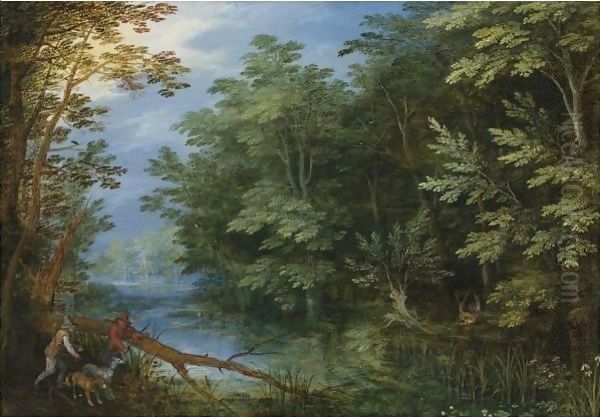
The artistic lineage extended through the maternal line as well. Jan's mother was likely Mayken Coecke van Aelst, the daughter of Pieter Coecke van Aelst, a prominent Antwerp painter, sculptor, and architect, and Mayken Verhulst. After Pieter Bruegel the Elder's death, it was Jan's maternal grandmother, Mayken Verhulst (c. 1518–1599), herself a respected painter known for miniatures and watercolors, who played a crucial role in the early artistic education of both Jan and his brother Pieter the Younger. This familial network provided a rich foundation in artistic practice and business from a very young age.
Early Life and Training
Following his father's early death, Jan Brueghel's upbringing was overseen by his grandmother, Mayken Verhulst. She moved with Jan and his brother to Antwerp shortly after 1569. It is widely documented that Mayken Verhulst provided Jan with his initial instruction in art, particularly in the demanding technique of watercolor and tempera painting. This early training in meticulous, detailed work likely laid the groundwork for the extraordinary precision and refined finish that would characterize his later oil paintings, especially those on smooth copper supports.
Beyond his grandmother's tutelage, sources indicate that Jan also studied oil painting with Pieter Goetkindt, an Antwerp painter and art dealer with a significant collection. Little is known about Goetkindt's own work, but his role as a dealer suggests he would have exposed the young Brueghel to a wide variety of contemporary and older art, further broadening his visual education. This combination of family instruction in detailed techniques and formal apprenticeship provided Jan with a solid technical foundation before he embarked on the next crucial phase of his development: travel.
The environment of Antwerp itself was formative. Despite the political and religious turmoil of the Dutch Revolt, Antwerp remained a vibrant center for art production and trade in the late 16th century. The city's guilds, workshops, and international connections created a dynamic atmosphere for an aspiring artist. Jan grew up immersed in this world, understanding the craft, the market, and the potential for artistic innovation.
The Italian Journey
Around 1589, following a path taken by many ambitious Northern European artists, Jan Brueghel traveled to Italy to study classical antiquity and the masters of the Italian Renaissance and contemporary art. This journey, lasting until 1596 or 1597, was profoundly influential, shaping his style, expanding his network, and introducing him to powerful patrons. His itinerary included stays in Naples, Rome, and Milan.

In Naples, he worked, although details of this period are scarce. His journey then took him to Rome, the epicenter of the art world, between 1592 and 1594. Here, he encountered a thriving community of artists, including fellow Fleming Paul Bril (1554–1626), a landscape painter whose work was evolving under Italian influence. Bril became a close friend and likely influenced Brueghel's approach to landscape composition and light. In Rome, Brueghel also met Hans Rottenhammer (1564–1625), a German painter specializing in small, highly finished cabinet pictures on copper, often featuring mythological or religious scenes. Their shared interest in this format likely led to collaborations and mutual influence.
The most significant connection Brueghel made in Italy was with Cardinal Federico Borromeo (1564–1631) in Milan. Brueghel entered Borromeo's service around 1595-1596. Borromeo was a highly influential churchman, a discerning art collector, and later the founder of the Biblioteca Ambrosiana. He became one of Brueghel's most important patrons and a lifelong friend, commissioning numerous works, particularly landscapes and flower paintings. Brueghel's detailed, naturalistic style greatly appealed to Borromeo's intellectual and aesthetic interests, which combined religious devotion with a keen observation of the natural world. The Cardinal's patronage provided Brueghel with financial stability and prestige.
The Italian experience exposed Brueghel to different approaches to landscape, color, and composition. He absorbed the lessons of Italian naturalism and the richness of Venetian color, integrating these elements with his Northern heritage of detailed observation. His time in Italy solidified his technical skills, expanded his thematic repertoire, and established crucial connections that would benefit his career upon his return north.
Return to Antwerp and Rise to Prominence
Jan Brueghel returned to Antwerp in 1596 or 1597, his reputation enhanced by his Italian travels and prestigious connections. He quickly established himself within the city's artistic community. In 1597, he was admitted as a master into the Antwerp Guild of Saint Luke, the professional organization for painters and other artisans. Membership was essential for establishing an independent workshop and taking on apprentices.
His talent and connections facilitated a rapid ascent. By 1601-1602, he served as the dean of the Guild, a position of considerable responsibility and prestige, indicating the high regard in which his peers held him. He established a successful workshop, likely employing assistants to help meet the growing demand for his work, particularly his detailed landscapes and innovative flower paintings.
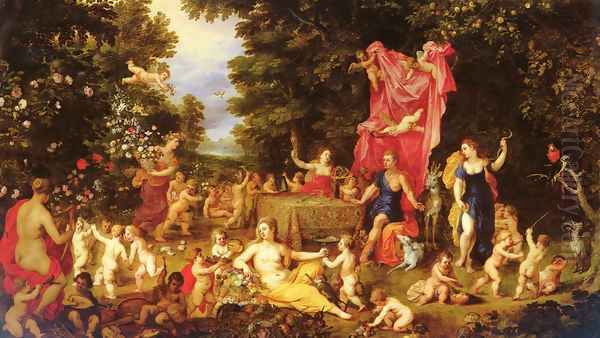
A significant mark of his success came in 1606 when he was documented working for the court of the Archdukes Albert VII and Isabella Clara Eugenia, the Habsburg governors of the Southern Netherlands, in Brussels. By 1609, he was formally appointed as court painter, a position he held until his death. This prestigious appointment provided him with a regular stipend and further elevated his status. While he maintained his primary residence and workshop in Antwerp, he frequently traveled to the court in Brussels. The Archdukes were avid collectors and patrons of the arts, and their support was crucial during this period, often referred to as the "Albertine" or "Isabelline" era, which saw a resurgence of Catholic culture and art in Flanders.
His success was built not only on his individual talent but also on his ability to collaborate. Antwerp's art scene fostered specialization, and Brueghel frequently worked with other masters, most notably Peter Paul Rubens, but also figures like Hendrick van Balen the Elder (1575–1632), Joos de Momper the Younger (1564–1635), and Hendrick de Clerck (c. 1560–1630). These collaborations allowed for the efficient production of high-quality works that combined the strengths of different artists.
The "Velvet" Touch: Style and Technique
Jan Brueghel the Elder earned the nickname "Velvet Brueghel" (Fluwelen Brueghel), a testament to the distinctive quality of his paintings. This moniker likely refers to the soft, luminous sheen of his works and the incredibly fine, almost imperceptible brushwork that rendered textures – from flower petals and insect wings to fabrics and distant foliage – with astonishing realism and delicacy. His technique was characterized by meticulous attention to detail, vibrant color, and a smooth, enamel-like finish, particularly evident in his paintings on copper.
He often preferred working on copper panels rather than wood or canvas, especially for smaller cabinet pictures. The smooth, non-absorbent surface of the copper allowed for extremely fine detail and enhanced the luminosity of the oil paints, contributing to the jewel-like quality of his work. He applied paint in thin, translucent layers (glazes), building up rich, saturated colors and subtle tonal variations. This demanding technique required immense patience and control.
His palette was typically bright and varied, employing expensive pigments like lapis lazuli for brilliant blues and carmine for deep reds. He masterfully handled light and atmosphere, often creating landscapes that recede convincingly into hazy, blue distances, demonstrating an understanding of atmospheric perspective inherited from his father but refined with his own sensibility.
While deeply rooted in the Northern tradition of precise observation, Brueghel's style also incorporated lessons learned in Italy. His compositions became more sophisticated, often employing diagonal recessions and carefully structured spatial arrangements. He balanced the Northern love for encyclopedic detail with a more Italianate sense of harmony and idealized beauty, particularly in his mythological and allegorical works. This fusion of Northern precision and Southern grace, executed with unparalleled technical skill, defined his unique "velvet" touch.
Pioneering Genres: Landscapes
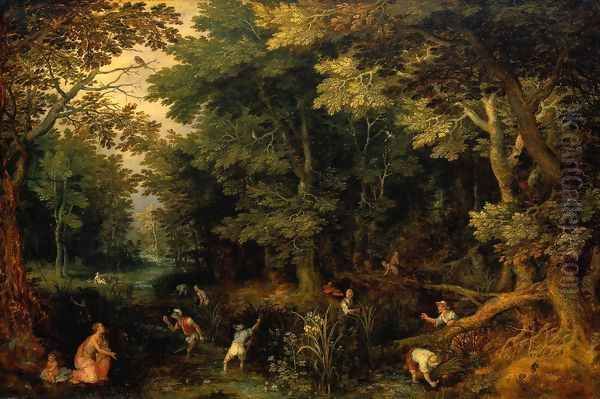
While Jan Brueghel the Elder worked within a landscape tradition established by his father and predecessors like Joachim Patinir, he significantly developed and diversified the genre. He moved beyond the high-viewpoint "world landscapes" favored by his father, creating more intimate and varied scenes, often characterized by lower viewpoints and more naturalistic compositions. His landscapes encompass a wide range, including forest interiors, village scenes, river views, coastal vistas, and the unique "paradise landscapes."
His forest landscapes, often dense and verdant, showcase his extraordinary ability to render foliage, tree bark, and undergrowth with botanical accuracy. These scenes are frequently populated with travelers, animals, or mythological figures, integrating narrative elements seamlessly into the natural setting. Works like A Wooded River Landscape (c. 1607-10) exemplify this detailed yet atmospheric approach.
Village and river landscapes depict Flemish life and scenery, but often idealized and imbued with a sense of tranquility and order. The River Landscape (1607) is a prime example, bustling with activity – boats, figures, animals, buildings – all rendered with meticulous care within a harmonious, expansive view unified by subtle light and atmosphere. He often used winding roads or rivers to lead the viewer's eye deep into the picture space.
Perhaps his most distinctive contribution was the "paradise landscape," a genre he essentially invented. These paintings typically depict the Garden of Eden, often focusing on the moment before the Fall or illustrating Noah's Ark. They provided a perfect vehicle for Brueghel's talent in rendering a vast array of animals and plants with encyclopedic detail. Works like The Entry of the Animals into Noah's Ark (1613) or The Garden of Eden with the Fall of Man (c. 1615, painted with Rubens) are vibrant celebrations of the natural world, showcasing exotic and familiar creatures coexisting peacefully in a lush, idealized setting. These works reflect contemporary interests in natural history and exploration, as well as theological themes.
Pioneering Genres: Flower Painting and Still Life
Jan Brueghel the Elder was a key figure in the emergence of flower painting as an independent genre in Northern European art. While flowers had appeared in religious manuscripts and portrait borders for centuries, Brueghel was among the first artists, alongside contemporaries like Ambrosius Bosschaert the Elder (1573–1621), to create easel paintings devoted entirely to elaborate floral bouquets.
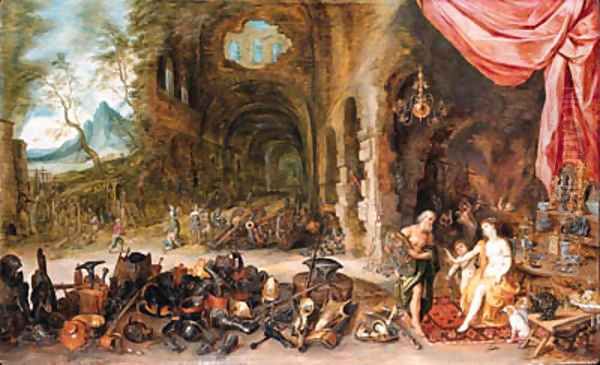
His flower paintings are characterized by their botanical accuracy, compositional density, and sheer virtuosity. He typically depicted flowers from different seasons blooming simultaneously, arranged in precious vases or simple baskets. These were not painted directly from life as a single arrangement but were composed from individual studies made when each flower was in bloom. This method allowed him to create idealized bouquets showcasing a wide variety of species, including rare and exotic tulips, roses, irises, and lilies, often alongside meticulously rendered insects like butterflies, dragonflies, and beetles.
These paintings were highly sought after by collectors like Cardinal Borromeo and the Archdukes. They appealed on multiple levels: as displays of technical skill, as celebrations of nature's beauty and diversity (reflecting the era's growing interest in botany and natural science), and often as carriers of complex symbolism. Flowers could represent the Virgin Mary, the transience of life (vanitas), or specific virtues. The inclusion of insects added further layers of meaning. Flowers in a Wooden Vessel (1606-1607) is a superb example of his mastery in this genre.
Beyond pure flower pieces, Brueghel also excelled in allegorical still lifes, most famously the series depicting The Five Senses, often painted in collaboration with Rubens between 1617 and 1618. In these complex compositions, Brueghel created lavish settings filled with objects related to each sense – musical instruments and songbirds for Hearing, flowers and perfumes for Smell, paintings and scientific instruments for Sight, abundant food and drink for Taste, and armor, jewelry, and medical tools for Touch. These works are encyclopedic displays of wealth, knowledge, and artistry, demonstrating Brueghel's ability to orchestrate vast amounts of detail into coherent allegorical statements.
Allegory, Myth, and Religion
Jan Brueghel the Elder's oeuvre extends significantly into allegorical, mythological, and religious subjects, reflecting the intellectual and cultural currents of his time. His detailed, naturalistic style lent itself well to imbuing these traditional themes with fresh visual interest and often complex layers of meaning. These works were popular with his elite patrons, who appreciated the combination of erudition and exquisite craftsmanship.
His allegorical paintings often explored abstract concepts through intricate compositions filled with symbolic objects. The series of The Five Senses (Prado, Madrid), created with Rubens, is a prime example. Each painting is a visual encyclopedia related to a specific sense, set within opulent interiors or lush landscapes that Brueghel rendered with astonishing detail. These works celebrate human perception and the richness of the world, while perhaps also hinting at the potential dangers of sensory indulgence, reflecting Counter-Reformation moral concerns. Other allegories might address themes like the Four Elements or the Ages of Man.
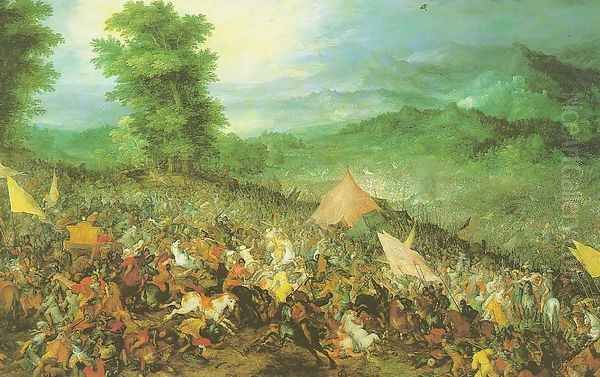
Mythological subjects, often drawn from Ovid's Metamorphoses, were also common. Brueghel frequently depicted scenes like Latona and the Lycian Peasants or Venus at the Forge of Vulcan, often collaborating with figure specialists like Hendrick van Balen or Rubens to paint the deities and heroes within his meticulously rendered landscapes or interiors. These works appealed to the humanist education of his patrons and allowed for the depiction of idealized beauty and dramatic narrative.
Religious themes remained central throughout his career, aligning with the Catholic resurgence in the Southern Netherlands under the Archdukes. He painted numerous biblical scenes, including his famous Paradise landscapes depicting Eden or Noah's Ark. He also created depictions of the Holy Family, the Adoration of the Magi, and various saints, often set within detailed landscapes or rich interiors. These works combined devotional content with his signature love for naturalistic detail, making the sacred stories visually accessible and engaging. His connection with Cardinal Borromeo ensured a steady demand for high-quality religious art.
A Network of Collaboration: The Partnership with Rubens
Collaboration between specialist painters was a common and efficient practice in Antwerp's bustling art market, but the partnership between Jan Brueghel the Elder and Peter Paul Rubens (1577–1640) stands out as one of the most brilliant and fruitful in art history. The two artists, preeminent in their respective fields – Brueghel in landscape and detail, Rubens in dynamic figures and grand compositions – were also close friends. Rubens was godfather to Brueghel's children, and Brueghel witnessed Rubens's marriage contract. Their collaboration began shortly after Rubens returned from Italy in 1608 and continued until Brueghel's death in 1625.
They produced around 25 documented collaborative works. Typically, Brueghel would lay out the landscape or setting with his characteristic precision, leaving spaces for Rubens to add the principal figures. Alternatively, Brueghel might add detailed elements like flowers, animals, or still-life objects to a composition primarily designed by Rubens. This division of labor played perfectly to their individual strengths, resulting in works of exceptional quality and richness that neither could have achieved alone.
Their most famous collaborations include The Garden of Eden with the Fall of Man (c. 1615, Mauritshuis), where Brueghel created the lush paradise teeming with animals and plants, and Rubens painted the figures of Adam and Eve. The series of The Five Senses (c. 1617–18, Prado) showcases Brueghel's encyclopedic still-life arrangements and opulent settings, animated by allegorical figures painted by Rubens. They also collaborated on mythological scenes, such as Pan and Syrinx, and devotional images like Madonna and Child in a Garland of Flowers, where Brueghel's exquisite floral wreath surrounds a central image by Rubens.
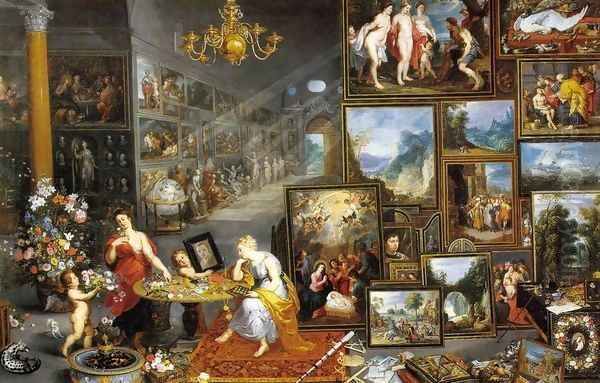
This partnership was based on mutual respect and admiration. Surviving correspondence reveals their discussions about commissions and artistic choices. Their combined talents resulted in highly desirable paintings that commanded high prices, eagerly sought by patrons like the Archdukes Albert and Isabella. The success of their collaboration highlights the synergy possible between great artists and reflects the dynamic, specialized nature of art production in early 17th-century Antwerp.
Other Collaborations
While the partnership with Rubens is the most celebrated, Jan Brueghel the Elder frequently collaborated with other leading Antwerp artists throughout his career. This practice allowed him to focus on his strengths – landscape, animals, flowers, and meticulous detail – while relying on specialists for large-scale figures or specific architectural elements, thereby increasing efficiency and market appeal.
Hendrick van Balen the Elder (1575–1632) was a frequent collaborator. Van Balen specialized in painting elegant, small-scale figures, often depicting mythological or religious scenes. Brueghel would create detailed landscape or interior settings, into which Van Balen would paint the figures. Numerous works depicting mythological feasts, biblical scenes like the Rest on the Flight into Egypt, or allegories resulted from this successful partnership.
Joos de Momper the Younger (1564–1635) was another significant collaborator. De Momper was a leading landscape painter known for his panoramic mountain views and winter scenes, often working in a broader, more atmospheric style than Brueghel. In some cases, Brueghel would add figures and animals to landscapes primarily painted by De Momper, enhancing their narrative interest and detail. Their styles complemented each other, creating popular and marketable works.
Other collaborators included Hendrick de Clerck (c. 1560–1630), a Brussels-based painter favored by the Archdukes, who specialized in elegant, Mannerist-style figures often found in Brueghel's mythological or allegorical landscapes created for the court. Sebastiaen Vrancx (1573–1647), known for his battle scenes and genre paintings, sometimes provided figures for Brueghel's landscapes. Frans Francken the Younger (1581–1642), from another prominent Antwerp painting dynasty, also collaborated, particularly on paintings featuring collector's cabinets or allegorical scenes filled with numerous small figures and objects. These collaborations underscore the interconnectedness of the Antwerp art world and Brueghel's central position within it.
The Workshop and the Market
Jan Brueghel the Elder operated a highly successful and productive workshop in Antwerp. The immense demand for his detailed landscapes, flower paintings, and collaborative works necessitated the employment of assistants and apprentices. While documentation about the specific workings of his studio is limited, its output suggests an organized system for producing high-quality paintings efficiently.
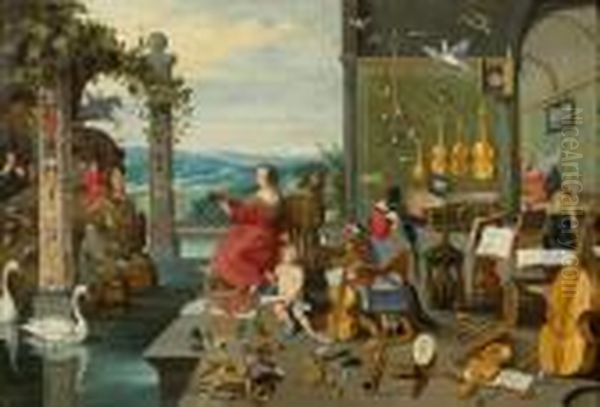
Assistants likely helped with preparing panels (especially the laborious grinding and polishing of copper plates), grinding pigments, transferring designs, and possibly painting less critical areas of compositions under the master's supervision. Brueghel's meticulous style, however, meant that significant portions of the most important works, particularly the fine details that were his hallmark, would have been executed by his own hand.
The workshop also produced replicas and variants of Brueghel's most popular compositions. This was a standard practice at the time, allowing the master to capitalize on successful formulas and meet broader market demand. These studio versions, while potentially involving less of the master's direct hand, maintained a high standard of quality and adhered closely to the original designs. This practice, however, contributes to the attribution challenges surrounding his oeuvre today.
Brueghel was an astute businessman, well-connected not only to courtly patrons like the Archdukes and Cardinal Borromeo but also to Antwerp's merchant class and international art dealers. His paintings commanded high prices, reflecting their quality, the labor involved, and his established reputation. His frequent collaborations were also economically savvy, pooling resources and talents to create desirable products. His success allowed him to live comfortably and maintain his status among Antwerp's elite artists. The Brueghel workshop was a significant enterprise, contributing substantially to Antwerp's reputation as a leading center of European art production.
Attribution Challenges: The Elder vs. The Younger
One of the significant challenges in studying Jan Brueghel the Elder's work lies in distinguishing his paintings from those produced by his workshop and, in particular, from the works of his son, Jan Brueghel the Younger (1601–1678). Jan the Younger trained with his father and took over the workshop after his father's sudden death from cholera in 1625.
Jan the Younger was a capable painter who continued his father's styles and themes, producing landscapes, allegories, and flower paintings that closely resembled his father's work. He inherited his father's stock of drawings and compositional patterns, which he frequently reused. He also continued collaborating with artists like Rubens (though less frequently) and others his father had worked with, such as Hendrick van Balen.
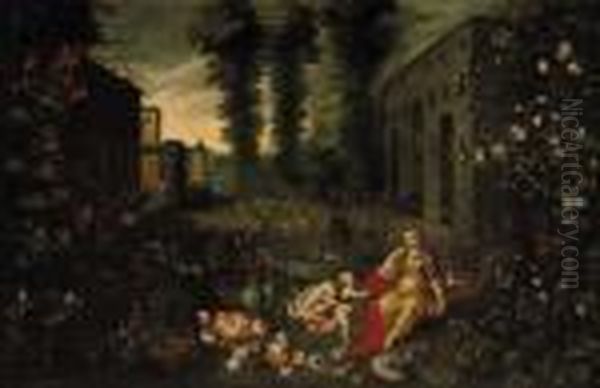
This stylistic continuity, combined with the workshop's practice of producing replicas, makes definitive attribution difficult, especially for works produced around the time of transition in the mid-1620s or for paintings that exist in multiple versions. While specialists can often discern differences in handling – Jan the Younger's touch is generally considered slightly broader, less refined, and his colors sometimes less vibrant than his father's – the distinctions can be subtle. Signatures can also be misleading, as Jan the Younger sometimes signed works in a manner easily confused with his father's, or later dealers may have altered signatures to enhance a painting's value.
Ongoing research, including technical analysis (examining underdrawings, paint layers, panel characteristics) and careful stylistic comparison, continues to refine the understanding of each artist's individual contribution. However, the close relationship between their work and the collaborative nature of studio production in the 17th century means that attribution questions will likely always remain for some paintings associated with the Brueghel name. This complexity underscores the importance of provenance research and expert connoisseurship.
Later Life and Legacy
Jan Brueghel the Elder remained highly productive and esteemed throughout his later career, enjoying the patronage of the Archdukes and maintaining his successful Antwerp workshop. His influence extended through his students and his son, Jan Brueghel the Younger, who was poised to carry on the family tradition.
Tragically, Jan Brueghel the Elder's life was cut short. In January 1625, a cholera epidemic swept through Antwerp, claiming the lives of Jan Brueghel and three of his children: Pieter, Cecilia, and Isabella. He was 56 years old. His death was a significant loss to the art world. Peter Paul Rubens expressed his grief in letters, mourning the loss of his close friend and collaborator.
Despite his untimely death, Brueghel's artistic legacy was secure. His son, Jan the Younger, took over the workshop and continued producing works in the family style, ensuring the Brueghel brand remained prominent in the art market for another generation. Jan the Younger's own sons, including Jan Pieter Brueghel, also became painters, extending the dynasty further.
Jan Brueghel the Elder's innovations in landscape and flower painting had a lasting impact. His detailed naturalism influenced subsequent generations of Flemish and Dutch artists specializing in these genres, including Daniel Seghers (1590–1661), a Jesuit painter famous for his flower garlands who studied briefly with Brueghel, and many others who adopted his meticulous technique and compositional ideas. His paradise landscapes remained popular, and his collaborative model continued to be employed by Antwerp artists.
Enduring Influence and Contemporary Relevance
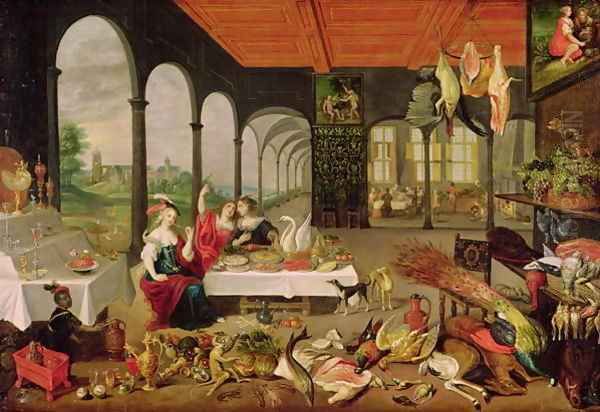
While Jan Brueghel the Elder's reputation perhaps dipped slightly in the 18th and 19th centuries compared to the towering fame of his father or his collaborator Rubens, the 20th and 21st centuries have seen a renewed appreciation for his unique talents and contributions. He is recognized not just as a member of an artistic dynasty but as a major innovator in his own right.
His pioneering role in developing independent landscape and flower painting is now fully acknowledged. Art historians value his work for its technical brilliance, its fusion of Northern detail and Italianate harmony, and its reflection of contemporary interests in natural science, exploration, and theology. His paintings offer invaluable visual records of the flora, fauna, and daily life of his time, filtered through an artistic lens of extraordinary refinement.
Museums worldwide treasure his works, and exhibitions dedicated to him and his collaborations continue to draw scholarly and public attention. His paintings remain highly sought after by collectors. The intricate detail and vibrant beauty of his works continue to fascinate viewers today. Themes present in his work – the beauty and fragility of nature, the relationship between humanity and the environment, the exploration of sensory experience – resonate with contemporary concerns.
His legacy is multifaceted: a master technician, an innovator of genres, a key figure in the Flemish Baroque, a successful collaborator and entrepreneur, and the progenitor of a continuing artistic lineage. Jan "Velvet" Brueghel the Elder secured his place as one of the most accomplished and influential painters of his era.
Conclusion
Jan Brueghel the Elder navigated the complex art world of the late 16th and early 17th centuries with remarkable skill and success. Emerging from the shadow of his famous father, he forged a distinct artistic identity characterized by meticulous detail, vibrant color, and thematic diversity. His innovations in landscape and flower painting established new benchmarks for these genres, while his collaborations, particularly with Peter Paul Rubens, produced some of the masterpieces of Flemish Baroque art. As a court painter, guild dean, and head of a productive workshop, he achieved significant professional and financial success. Despite challenges in attribution due to workshop practices and the work of his son, Jan Brueghel the Elder's legacy endures. His paintings continue to captivate audiences with their exquisite beauty and intricate depiction of the natural and man-made worlds, securing his position as a pivotal and highly esteemed master of European art.